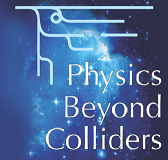Speaker
Description
Weakly interacting slim particles (WISPs) are searched for in purely laboratory based experiments with the so-called light-shining-through-a-wall (LSW) approach. Here the detection of axion and axion-like particles, which seem to be the best motivated WISPs from theoretical considerations, requires the presence of a long and strong magnetic field perpendicular to the light path. Current experimental activities are OSQAR at CERN and ALPS II presently under preparation at DESY. At ALPS II, dedicated complex optics, largely based on experiences gained in the context of LIGO, new detector technologies and modified dipoles from the HERA proton ring will be combined.
In the future one could envisage a physics case strongly asking to increase the sensitivity of LSW experiments beyond the present scope. For example, direct dark matter experiments or solar observations might discover a light axion-like particle requiring to measure its properties unambiguously in a purely laboratory based experiment. In this contribution we will sketch scopes and limitations of “ultimate” LSW experiments based on advanced high field magnets presently under development in the frame of HL-LHC and FCC. It is evident that the corresponding high costs of such installations will require a very clear and convincing physics case.




